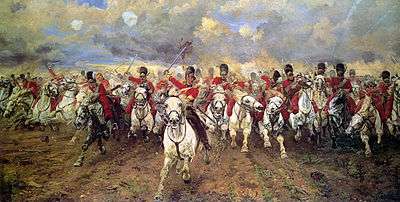James Hamilton (British Army officer, born 1777)
| James Inglis Hamilton | |
|---|---|
| Birth name | Jamie Anderson |
| Born |
4 July 1777 Tayantroga |
| Died |
18 June 1815 (aged 37) Waterloo, Belgium |
| Allegiance |
|
| Service/branch |
|
| Years of service | 1792–1815 |
| Rank | Lieutenant colonel |
| Battles/wars | |
| Relations |
|
Lieutenant colonel James Inglis Hamilton (born Jamie Anderson, 4 July 1777 – 18 June 1815) was a Colonel in the British Army killed at the Battle of Waterloo.
Early life
He was born as Jamie Anderson on 4 July 1777 at a camp of the Saratoga Campaign in New York. He was the second son of William Anderson, a Sergeant-Major of the 21st Foot.[1] Hamilton was baptized on 28 August 1777.[2] General James Inglis Hamilton adopted him following the Battle of Bemis Heights, and funded his education at Glasgow Grammar School.[1]
Military career
Hamilton's adopted father opened a spot in the British Army and Hamilton became a cornet in the Royal Scots Greys in 1792.[2] This is when he changed his name to James Hamilton.[2] Hamilton was promoted to lieutenant on 4 October 1793.[2] On 15 April 1794, he was promoted to captain.[2] Hamilton became major on 17 February 1803.[2] He was promoted to lieutenant colonel on 16 June 1807,[2] and he commanded the Royal Scots Greys.[1] On 4 June 1814, Hamilton was promoted to Colonel.[3]
Battle of Waterloo

By the time of the Battle of Waterloo he was a Lt. Colonel, commanding the Royal Scots Greys. While leading a charge on horseback, he lost his left arm. He put the reins in his mouth and continued the charge, even after his right arm was severed by a French lancer. Moments later he was shot and killed. He was found with a bullet wound through his heart, as well as other injuries; Hamilton's scabbard and silken sash were sent to his brother,[1] Lieutenant Jno. Anderson, who died in Glasgow on 3 December 1816 from wounds received at the Battle of Salamanca.[2]
Personal life
Hamilton married Mary Inglis Payne.[4] Upon Hamilton's death, Payne was compensated £200.[2]
He inherited Murdostoun Castle from his father on 18 August 1803.[5]
Notes
References
- Almack, Edward (1908). The history of the Second dragoons: "Royal Scots greys". Alexander Moring. OCLC 8786681.
- Dalton, Charles (1904). The Waterloo roll call: with biographical notes and anecdotes (2 ed.). Eyre and Spottiswoode.
- Dunbar, W. H. (1839). The Scottish jurist. M. Anderson. OCLC 668229392.
- Estimates and Accounts: Army; Navy; Civil List; Pensions; &c. 1817.
- Summerville, Christopher J. (2007). Who was who at Waterloo: a biography of the battle. Harlow, Essex, England: Longman. ISBN 978-0-582-78405-5.